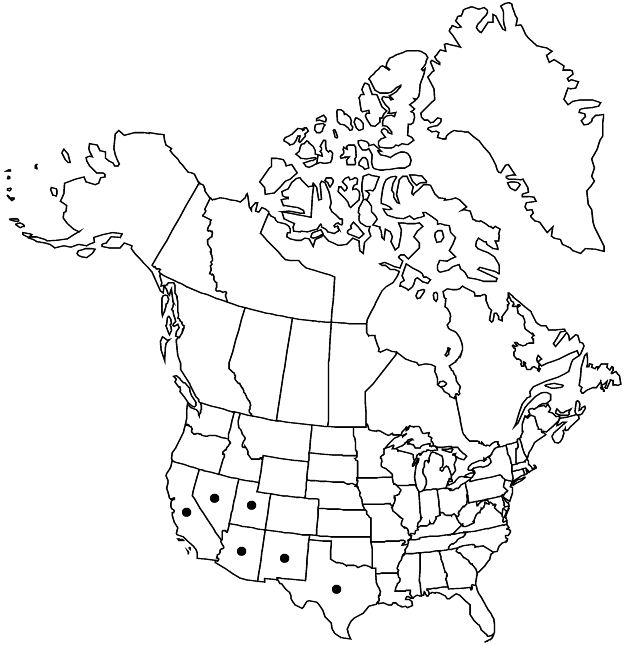Difference between revisions of "Kallstroemia californica"
Bull. Torrey Bot. Club 22: 230. 1895.
FNA>Volume Importer |
FNA>Volume Importer |
||
| Line 14: | Line 14: | ||
|name=Kallstroemia brachystylis | |name=Kallstroemia brachystylis | ||
|authority=Vail | |authority=Vail | ||
| − | }}{{Treatment/ID/Synonym | + | }} {{Treatment/ID/Synonym |
|name=K. californica var. brachystylis | |name=K. californica var. brachystylis | ||
|authority=(Vail) Kearney & Peebles | |authority=(Vail) Kearney & Peebles | ||
| Line 32: | Line 32: | ||
|elevation=0–1600 m. | |elevation=0–1600 m. | ||
|distribution=Ariz.;Calif.;Nev.;N.Mex.;Tex.;Utah;c;n Mexico. | |distribution=Ariz.;Calif.;Nev.;N.Mex.;Tex.;Utah;c;n Mexico. | ||
| − | |discussion=<p>Kallstroemia californica is found throughout the Chihuahuan, Mojave, and Sonoran deserts, mainly at lower elevations.</p><!-- | + | |discussion=<p><i>Kallstroemia californica</i> is found throughout the Chihuahuan, Mojave, and Sonoran deserts, mainly at lower elevations.</p><!-- |
| − | --><p>Kallstroemia californica plants with fewer leaflets and less pronounced fruit tubercles have been called K. brachystylis (K. californica var. brachystylis), but variation in these characters is continuous and two taxa cannot be distinguished. Recognition of two taxa in the past arose primarily from the determination of a number of immature or depauperate specimens of K. parviflora as K. brachystylis (D. M. Porter 1969).</p> | + | --><p><i>Kallstroemia californica</i> plants with fewer leaflets and less pronounced fruit tubercles have been called K. brachystylis (<i>K. californica</i> var. brachystylis), but variation in these characters is continuous and two taxa cannot be distinguished. Recognition of two taxa in the past arose primarily from the determination of a number of immature or depauperate specimens of <i>K. parviflora</i> as K. brachystylis (D. M. Porter 1969).</p> |
|tables= | |tables= | ||
|references= | |references= | ||
| Line 57: | Line 57: | ||
|publication year=1895 | |publication year=1895 | ||
|special status= | |special status= | ||
| − | |source xml=https://jpend@bitbucket.org/aafc-mbb/fna-data-curation.git/src/ | + | |source xml=https://jpend@bitbucket.org/aafc-mbb/fna-data-curation.git/src/8f726806613d60c220dc4493de13607dd3150896/coarse_grained_fna_xml/V12/V12_134.xml |
|genus=Kallstroemia | |genus=Kallstroemia | ||
|species=Kallstroemia californica | |species=Kallstroemia californica | ||
Revision as of 14:43, 18 September 2019
Herbs, annual. Stems prostrate to decumbent, to 0.7 m, hirsute and strigose with white antrorse hairs, becoming glabrate. Leaves usually elliptic in outline, sometimes obovate, 1.5–6 × 1–3 cm; stipules 1.5–5 × 1 mm; leaflets 6–12(–14), elliptic to oblong, 4–17 × 1.5–9 mm, middle pairs usually largest, terminal pairs sometimes largest, surfaces appressed-hirsute, veins and margins sericeous, becoming glabrate. Pedicels to 15 mm in flower, 8–33 mm in fruit, shorter than subtending leaves, thickened distally, bent sharply at base and straight distally. Flowers 8–10 mm diam.; sepals usually deciduous, if persistent spreading from base of schizocarp, lanceolate, 2–4 × 1–1.5 mm, 2/3 as long as petals, in flower longer than style, in fruit not reaching tops of mature fruit body, margins becoming involute, strigose or hirsutulous and strigillose; petals marcescent, 1-colored, yellow, drying white or orange, obovate, 3–6 × 2.5–3 mm; stamens as long as style; anthers yellow, ovoid, to 1 mm; ovary ovoid, 1 mm diam., hairy; style conic, to 1 mm, shorter than ovary, strigillose; stigma terminal. Schizocarps ovoid, to 4 × 3–5 mm (including tubercles), strigillose; beak cylindric, 2–4 mm, shorter than fruit body, base conic, glabrous or base sparingly strigillose; mericarps 3 × 1 mm, abaxially tuberculate, 4–5 tubercles blunt oblong, 1–1.5 mm (tubercles becoming more prominent as fruits mature), other tubercles rounded, much less than 1 mm, sides pitted or smooth, adaxial edge angled.
Phenology: Flowering Mar–Oct.
Habitat: Flat, sandy, disturbed areas in desert and semiarid grasslands.
Elevation: 0–1600 m.
Distribution

Ariz., Calif., Nev., N.Mex., Tex., Utah, c, n Mexico.
Discussion
Kallstroemia californica is found throughout the Chihuahuan, Mojave, and Sonoran deserts, mainly at lower elevations.
Kallstroemia californica plants with fewer leaflets and less pronounced fruit tubercles have been called K. brachystylis (K. californica var. brachystylis), but variation in these characters is continuous and two taxa cannot be distinguished. Recognition of two taxa in the past arose primarily from the determination of a number of immature or depauperate specimens of K. parviflora as K. brachystylis (D. M. Porter 1969).
Selected References
None.